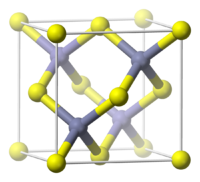
Photo from wikipedia
Abstract The CdTe/CdS heterojunction whose interfacial properties have great influence on the performance of cells is the core part of the CdTe thin film solar cells. Therefore, the first-principles calculation… Click to show full abstract
Abstract The CdTe/CdS heterojunction whose interfacial properties have great influence on the performance of cells is the core part of the CdTe thin film solar cells. Therefore, the first-principles calculation method based on density functional theory is applied to theoretically study electronic structures and optical properties of the CdTe/CdS heterojunction interface. The characteristics of CdTe and CdS bulk, CdTe (111) and CdS (002) surfaces as well as the perfect and defective CdTe/CdS interfaces are calculated and analyzed respectively. Band structures, density of states and optical absorption properties of different models are analyzed. These results show that the CdTe (111)/CdS (002) interface has the lowest total energy when the interlayer distance is 1.82 A. For the perfect interface, only a few interface states exist in the band gap. Whereas, for the defective interface, the interface states exist in the vicinity of the Fermi energy level which are mainly composed of Cd-5s, Te-5p and S-3p electronic states. In addition, the optical properties of surfaces and interfaces are different from bulks due to surface states and interface states. What's more, the absorption peak of the defective interface is significantly lower than that of the perfect interface.
Journal Title: Physica B: Condensed Matter
Year Published: 2018
Link to full text (if available)
Share on Social Media: Sign Up to like & get
recommendations!